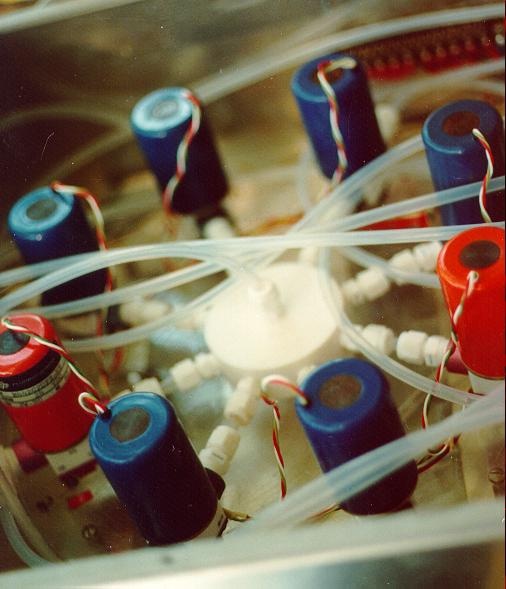
 The automated Environmental Monitoring Station (EMS) monitors the concentration of a variety of chemical species, in addition to general environmental measurements. These species include NOy, NOx, CO2, H2O, O3, CO, and several different hydrocarbons (For a complete list see the table below). We measure the net flux hourly aggregating to seasons, years, and decades. Methods used to calculate concentrations include infrared and UV-Vis spectrophotometry, chemiluminescence, and gas chromatography. Measurements of carbon dioxide and trace gases have been nearly continuous since 1990, and data through 1999 is publicly available through our data exchange.
The automated Environmental Monitoring Station (EMS) monitors the concentration of a variety of chemical species, in addition to general environmental measurements. These species include NOy, NOx, CO2, H2O, O3, CO, and several different hydrocarbons (For a complete list see the table below). We measure the net flux hourly aggregating to seasons, years, and decades. Methods used to calculate concentrations include infrared and UV-Vis spectrophotometry, chemiluminescence, and gas chromatography. Measurements of carbon dioxide and trace gases have been nearly continuous since 1990, and data through 1999 is publicly available through our data exchange.

This schematic representation of the CO2 eddy measurement shows how the CO2 measurement is calibrated by standard addition. A small flow of calibration gas is added to the sample flow of 5-6 lpm. The pressure in the detector cell is measured and controlled. Total flow in the system is measured in order to identify periods with filter clogging and to do the calibration calculations. Calibration of NOx and NOy measurements also use standard addition and have similar plumbing.
 8 inlets are arranged from 30 cm to 30m on or near the tower. Each inlet is selected in turn by activating a solenoid on the "hub" pictured above. Teflon is used to minimize alteration of O3 and NOx concentrations. The entire sampling line is at a constant reduced pressure to prevent condensation of water vapor.
8 inlets are arranged from 30 cm to 30m on or near the tower. Each inlet is selected in turn by activating a solenoid on the "hub" pictured above. Teflon is used to minimize alteration of O3 and NOx concentrations. The entire sampling line is at a constant reduced pressure to prevent condensation of water vapor.
For more information about our instruments and how we make our measurements contact Bill Munger or John Budney.
List of sensors and quantities measures on eddy-flux tower at Harvard Forest.
| Sensor | inlet/ instrument altitudes | determined quantity (data rate) | Dates Active |
|---|---|---|---|
| ATI Sonic Anemometer | 30m | Three-dimensional wind velocity, temperature, momentum & heat fluxes (30-min avg) | Ongoing |
| NOy (catalyst-->NO) | 30m | NOy fluxes, 30-minute averages | 1992-2002 |
| high-speed CO2-H2O IR-Absorbance | 30m | CO2 and H2O fluxes (30-min avg) | Ongoing |
| high-speed O3 C2H4 - chemiluminescence | 30m | Ozone flux (30-min avg) | 1992-2002 |
| slow CO2 IR absorbance |
30,24,18,12,6, 3,1,0.05m |
CO2 concentration along a vertical profile (8 levels @ 2/hr) |
Ongoing |
| slow O3 UV absorbance |
30,24,18,12,6, 3,1,0.05 m |
O3 concentration along a vertical profile (8 levels @ 2/hr) |
Ongoing |
| slow NOx (Photolysis, O3-chemiluminescence) |
30,24,18,12,6, 3,1,0.05m |
NO, NO2 concentration along a vertical profile (8 levels @ 2/hr) | 1992-2002 and intermittently since |
| Thermistor, thin-film capacitor |
30,22,12,6, 3m |
Temperature and relative humidity profile (5,60-min avg) | Ongoing |
| Thermistors |
surface (6 reps), 20cm, 50cm |
soil temperatures (5,60-min avg) | Ongoing |
| PAR sensors | 30,12m |
photosynthetically active radiation (5,60-min avg) |
Ongoing |
| Net radiometer | 30m | net radiative heat flux (5,60-min avg) | Ongoing |
| CO Gas-filter correlation IR absorbance | 30m | CO concentrations (4,60-min avg) |
Dasibi 1992-2002 Teledyne 2012-present |
| GC-FID | 30m | 1CH4 concentrations(60-min avg) | 1992-1994 |
| 2-Channel GC-FID |
29,24m gradient for fluxes |
C2-C6 hydrocarbon concentrations (2/hr) |
1992-1995 Goldstein et al 1995 |
| 4-Channel GC-ECD (FACTS) | 29m | Halocarbons, N2O, CO, CH4, SF6 |
1996-1998 |
| 1-channel GC | 30m | PAN | suspended |
| Tuneable Diode laser absorption spectrometer | 30m | NO2 and HNO3 | 2000 |
| Quantum Cascade Laser absorption spectrometer | 30m | NO2 and HONO | 2011 |